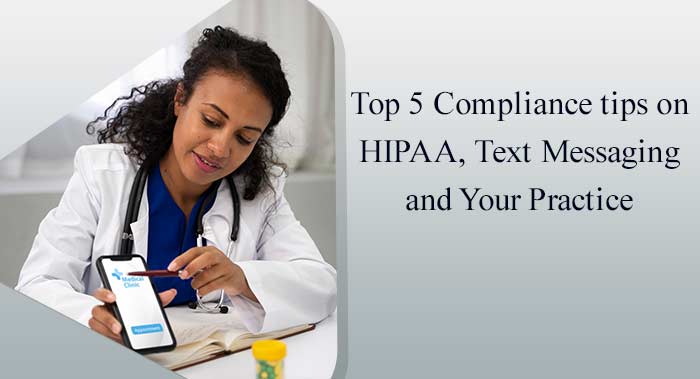
Top 5 Compliance Tips on HIPAA, Text Messaging, and Your Practice
After the pandemic, texting and telecommunications have become a convenient way to communicate for healthcare organizations and patients. More than 80% of Americans find text messaging efficient, affordable, and has better reach. While text messaging shares many benefits, it also comes with several challenges. Whenever a patient's sensitive medical record and information are involved, providers need to be extra careful to ensure no HIPAA violation on their end, practicing HIPAA compliance for websites, apps, and other platforms. However, any negligence can get them in big legal trouble and can cause them to lose patients' trust.
Therefore, it's important for healthcare professionals and patients to understand HIPAA-compliant texting and the essential practices to safeguard patient's privacy. Let's delve into this article and look at the emerging trends of patient-provider communication and texting challenges.
HIPAA-Compliant Texting and Use in Recent Healthcare Landscape
HIPAA-compliant text messaging refers to a secure method of transmitting protected health information (PHI) via text message. This method ensures that sensitive patient data remains confidential, secure, and protected from unauthorized access or breaches. Recent advancements in technology have facilitated the integration of secure messaging platforms specifically designed for healthcare settings, enabling healthcare providers to communicate efficiently with patients and colleagues while adhering to HIPAA standards.
To maintain HIPAA compliance, it is essential to implement adequate technical safeguards for electronic communications, minimizing the risk of breaches or data theft. Text messaging commonly occurs between healthcare facilities and patients or among healthcare service members. When PHI is involved, all parties must prioritize confidentiality, integrity, and security.
Standard SMS messaging does not meet HIPAA standards and poses risks as messages are stored on service provider servers, presenting potential vulnerabilities. However, leveraging the benefits of fast and convenient communication is possible through HIPAA-compliant text messaging solutions. It's important to note that not all communications related to health services constitute PHI, but when dealing with sensitive patient information, adherence to HIPAA regulations is paramount.
Need for HIPAA-Compliant Chat or Texting Solutions
Despite rapid technological advancements in healthcare, communication remains a critical challenge. From ensuring efficient exchanges among providers to engaging patients effectively, the sector grapples with complexity, confidentiality, and urgency. Texting has emerged as a valuable tool for patient engagement, offering immediacy and convenience. It facilitates appointment reminders, treatment follow-ups, and health advice, aligning with patients' preferences for quick information.
However, non-compliant texting causes risks, violating HIPAA regulations and compromising patient privacy. Breaches not only incur fines but also damage trust and reputation. HIPAA-compliant texting is crucial, balancing efficient communication with regulatory compliance. By embracing HIPAA compliance for websites, healthcare providers enhance patient care, reinforce privacy standards, and safeguard sensitive information, bolstering trust and integrity in the healthcare ecosystem.
Best 5 Practices for HIPAA-Compliant Texting
So, now acknowledging the above factors, how do you assure complete compliance in patient texting? Here are the top 5 practices that you can apply to your patient engagement and communication.
1. Understand the rules for text messaging
Before getting into anything in-depth, it's important to understand the importance of complying with HIPAA text messaging rules in healthcare. Covered entities, including healthcare providers, health plans, and business associates dealing with protected health information (PHI), are subject to HIPAA regulations. Failure to comply can lead to fines of up to $1.5 million, ongoing oversight, and loss of patient trust. Utilizing secure messaging platforms tailored to HIPAA requirements is essential to avoid unintentional violations and safeguard sensitive patient data.
2. Use a secure messaging or chatting platform
Choosing the right messaging system is the cornerstone of HIPAA compliance in healthcare. According to the HHS, HIPAA mandates that business associates, including technology providers, safeguard protected health information (PHI) through Business Associate Agreements (BAA). Patient engagement platforms prioritize security, utilizing encryption to render data unreadable and protect against theft or alteration. Additionally, features such as secure databases, time-out functions, user permissions, access controls, and audit logging further ensure PHI confidentiality. Beyond compliance, utilizing patient communication systems offers enhanced tools like two-way texting and telehealth, streamlining operations and improving patient engagement.
3. Staff training and awareness
Efficient training and awareness programs can ensure HIPAA-compliant chat. HIPAA's Security Rule necessitates regular security training and periodic retraining for all staff members. For outpatient practices like physical therapy and rehabilitation centers, additional measures such as internal policy implementation and emphasizing personal responsibility are crucial. Staff should be educated on HIPAA compliance, secure messaging protocols, and proper handling of protected health information (PHI) via text. Regular training sessions and accessible resources foster proficiency and cultivate a culture of privacy and security within the organization.
4. Inform patients about the risk
Prior to texting patients, ensure they understand potential risks like interception, device loss, or unauthorized access. Use a HIPAA-compliant texting app that offers secure messaging. There are a range of safe messaging platforms that can ease your HIPAA-compliant journey. Check their secure texting features before utilizing them. Retain conversation history for accountability. For instance, if a patient misses a checkup reminder and later blames you, having the conversation history can protect you. Document such exchanges for future audits.
5. Regular risk assessments
Regular risk assessments are crucial for identifying security gaps and preventing breaches in rehabilitation practices. These assessments cover physical, technical, and administrative safeguards by defining accessible PHI, assessing security measures, identifying gaps, evaluating risks, and documenting the process. Implementing security measures is essential to maintain HIPAA compliance for websites and other texting platforms.




